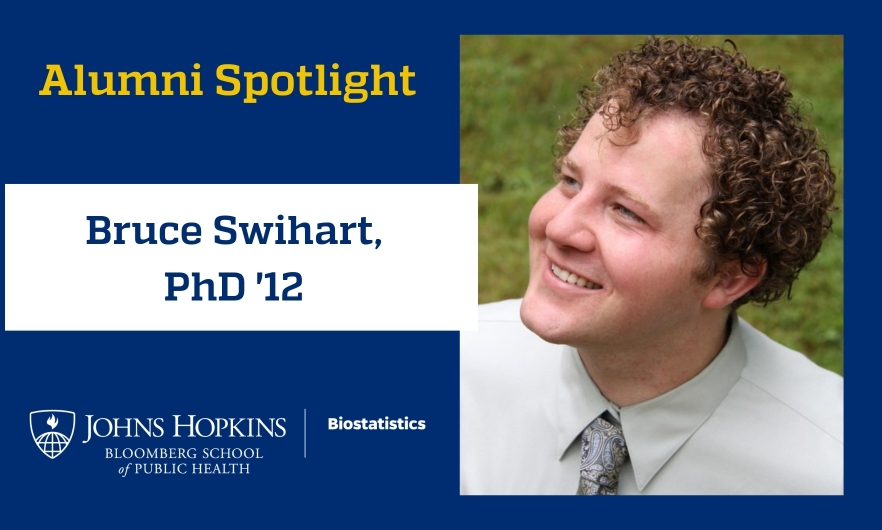Bruce Swihart, PhD '12
Bruce Swihart, PhD '12, is currently a mathematical statistician at the National Institutes of Health.

Bruce Swihart, PhD '12, is currently a mathematical statistician at the National Institute of Allergy and Infectious Diseases.
Swihart wrote his PhD thesis, "From Individuals to Populations: Application and Insights Concerning the Generalized Linear Mixed Model," under the direction of Brian Caffo. He was also a postdoctoral fellow in the Department working with Ciprian Crainiceanu. During his postdoc he developed zero variance component tests for functional data analysis and orchestrated a top 1% in Kaggle's Heritage Health Prize competition.
How did you get interested in the field of biostatistics? What was your background before enrolling at Hopkins?
I have a BS in applied mathematics and an MS in biostatistics, both from the University of Colorado network of campuses, cities, and centers (BS in Boulder, MS in Denver). Before graduating high school, I read about biostatistics in Careers for Dummies. After some junior-level probability and statistics courses as an undergraduate, I knew the subject matter of the involved mathematics alone were of personal interest and if I could apply the methods to the medical field, I would be professionally fulfilled.
Describe your current position and responsibilities in a way that will inform prospective students about career opportunities in biostatistics.
My current position is a mathematical statistician at the NIH, specifically NIAID. My particular department is structured like an academic one in that I do both applied statistics and methodological research. My collaborative and applied statistics projects help researchers in areas as diverse as Malaria and Tuberculosis and Drug-Resistant Antibiotics make decisions about their studies. My methodological developments are contributions to the field of statistics and include new ways to calculate distributions to exploring the connection between making inferences about individuals and populations at the same time.
How did Johns Hopkins Biostatistics prepare you for your career? What aspects of the program did you find most useful?
Most useful was the rare combination of every professor being so smart, enthusiastic and articulate yet extremely approachable and often available for conversations. Johns Hopkins Biostatistics prepared me for my career via the apprenticeship model: I was sitting in on my professors' collaboration and consultation meetings, co-writing papers of methodological and applied science merit in addition to receiving world-class instruction in my coursework. The opportunity to serve as a teaching assistant was also rewarding and helped hone my communication and preparation skills.
What are your favorite memories of your time at Johns Hopkins Biostatistics?
Too many to recount—I will list them in a scurrying, stream-of-consciousness way, like a montage in a feel-good movie: poker games with faculty and students; tea times discussing the finer points of Con Air; cooking club and Pi(e) day with students in our department from international cultures with international cuisines; hosting the prospective students in a city that I have come to love; Brian Caffo's Halloween party; the annual chili parties; the departmental retreats in Gettysberg and Philadelphia; seeing my department-mates defend and graduate; missing the bus late one night in Seattle (JSM 2006) and having to (being allowed to?) crash in my advisor's hotel room; Patty's TLC for Wednesday seminars; Patty's brassy banter with Professor Rohde; within a period of 48 hours giving a journal club presentation, preliminary oral examination, clandestinely moving apartments, going to the Hopkins Winter Party, and proposing to (and surprising) my wife; hosting and residing with Henry Mwambi (visiting Biostatistics faculty member) for a summer; learning how to swing dance; running two marathons; the Tulip Gardens north of the Homewood Campus; the departmental holiday party (and faculty-roasting skits); celebrating births in the department (especially the one of my first child); birthday cake for birthdays in the department; Professor Louis's wife's cookies; Monday night football with Haley and Sam, etc.
Is there any other information about your experience at Hopkins that would be useful for prospective students?
You will be hard-pressed to find elsewhere the camaraderie among faculty, among students, and between faculty and students that exists here at Hopkins Biostatistics. As you are evaluating other schools, keep an eye and ear out for said camaraderie and don't undervalue how important it can be to your academic pursuits. I have found the camaraderie to be my favorite and most valued feature of the department and my time earning a PhD degree.
Please list any notable accomplishments that you would like us to highlight.
- 2009 June B. Culley Award
- 2011 Helen Abbey Award
- 2008 Louis I. and Thomas D. Dublin Award
- Top 1% finish in Kaggle's Heritage Health Prize competition
